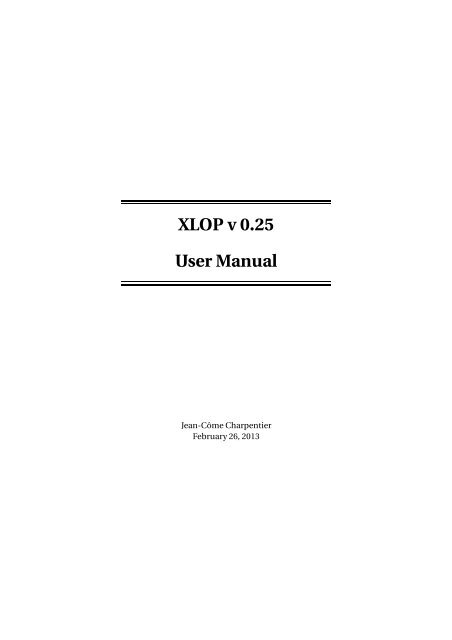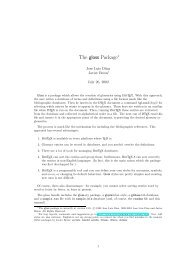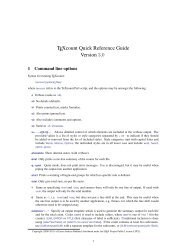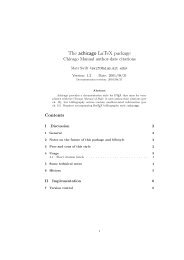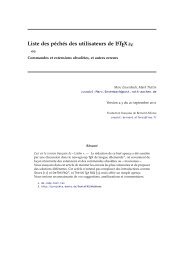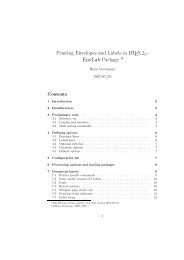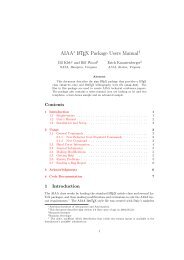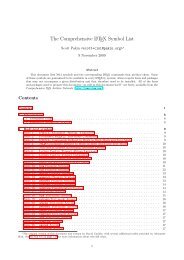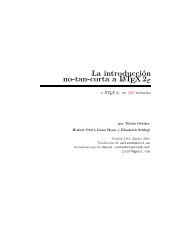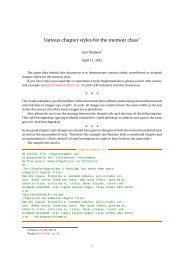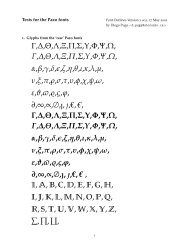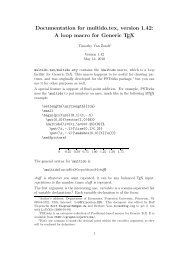Create successful ePaper yourself
Turn your PDF publications into a flip-book with our unique Google optimized e-Paper software.
XLOP v 0.25User ManualJean-Côme CharpentierFebruary 26, 2013
Contents1 Overview 12 <strong>xlop</strong> Instructions 42.1 In the Beginning Was the Number . . . . . . . . . . . . . . . . . 42.1.1 Size . . . . . . . . . . . . . . . . . . . . . . . . . . . . . . . 42.1.2 Syntax . . . . . . . . . . . . . . . . . . . . . . . . . . . . . 52.2 <strong>xlop</strong> Parameters . . . . . . . . . . . . . . . . . . . . . . . . . . . . 52.2.1 Symbols . . . . . . . . . . . . . . . . . . . . . . . . . . . . 62.2.2 General Displaying . . . . . . . . . . . . . . . . . . . . . . 62.2.3 Dimensions . . . . . . . . . . . . . . . . . . . . . . . . . . 82.2.4 Figure’s Styles . . . . . . . . . . . . . . . . . . . . . . . . . 93 Arithmetic Operations 123.1 Addition . . . . . . . . . . . . . . . . . . . . . . . . . . . . . . . . 123.2 Substraction . . . . . . . . . . . . . . . . . . . . . . . . . . . . . . 133.3 Multiplication . . . . . . . . . . . . . . . . . . . . . . . . . . . . . 153.4 Division . . . . . . . . . . . . . . . . . . . . . . . . . . . . . . . . . 173.4.1 End Control . . . . . . . . . . . . . . . . . . . . . . . . . . 183.4.2 Other Features . . . . . . . . . . . . . . . . . . . . . . . . . 203.4.3 Non Integer Numbers and Negative Numbers . . . . . . 214 Other Commands 234.1 Starred Macros . . . . . . . . . . . . . . . . . . . . . . . . . . . . 234.2 Input-Output . . . . . . . . . . . . . . . . . . . . . . . . . . . . . 234.3 Figures of Numbers . . . . . . . . . . . . . . . . . . . . . . . . . . 254.4 Comparisons . . . . . . . . . . . . . . . . . . . . . . . . . . . . . 264.5 Advanced Operations . . . . . . . . . . . . . . . . . . . . . . . . . 27A Short Summary 32A.1 Compilation times . . . . . . . . . . . . . . . . . . . . . . . . . . 32A.2 Macros List . . . . . . . . . . . . . . . . . . . . . . . . . . . . . . . 34A.3 Parameter list . . . . . . . . . . . . . . . . . . . . . . . . . . . . . 36B Tricks 40B.1 <strong>xlop</strong> vs. calc and fp . . . . . . . . . . . . . . . . . . . . . . . . . . 40B.2 Complex Operations . . . . . . . . . . . . . . . . . . . . . . . . . 41B.3 Direct Access to Number . . . . . . . . . . . . . . . . . . . . . . . 44i
C Future Versions 46D Index 48ii
+4 5,0 57 8,41 2 3,4 5source\opadd[decimalsepsymbol={,},voperator=bottom,carryadd=false]{45.05}{78.4}Note the trick which consists to put the comma between braces in the decimalseparator symbol definition. In fact, if you say:source\opadd[decimalsepsymbol=,,voperator=bottom,carryadd=false]{45.05}{78.4}<strong>xlop</strong> drives mad! It don’t understand what is this sort of list!Another important point, though it is less apparent, is that the figuresare put in very precise places. Each figure is put in a box of fixed width andfixed height (user can change these values), decimal separator is put in anull-width box (by default), and the lines have a regular interspace (with orwithout horizontal rule). This allows exact spacing and to place what wewant where we want.+14 5.0 57 8.41 2 3.4 5carrysource\psset{xunit=\opcolumnwidth,yunit=\oplineheight}\opadd{45.05}{78.4}\oplput(1.5,3){carry}\psline{>}(1,3.15)(3.25,3.15)This example uses package pstricksWe have said that <strong>xlop</strong> package is able to deal with arbitrary sized numbers.We come again about this subject and, for now, we just give an examplewhich shows what is possible. Don’t look at the code, some explanationswill be given later in this manual, for now just admire the result!source\opdiv[style=text,period]{1}{49}1÷49=0.020408163265306122448979591836734693877551...The package <strong>xlop</strong> provides some other features. It is possible to manipulatenumbers through variables. These variables can be created with anassignation or as a computation result. You can also manipulate the figuresindividually:The first figure after dot of45.05+78.4 is 4.source\opadd*{45.05}{78.4}{r}%The first figure after dot of$45.05+78.4$ is\opgetdecimaldigit{r}{1}{d}%$\opprint{d}$.you can make tests:2
Chapter 2<strong>xlop</strong> InstructionsExcept some macros which will be examined later, the <strong>xlop</strong>’s macros canhave an optional argument between squared braces in order to localy modifyparameter’s values. The other arguments (mandatory) are (nearly) alwaysnumbers. The two sections of this chapter describe in details what isa number for <strong>xlop</strong> and how use parameters.2.1 In the Beginning Was the Number2.1.1 SizeBefore we see the general syntax of number, we examin the very particular<strong>xlop</strong> feature: the ability to deal with arbitrary sized number.To be precise, the theoric maximum size of a number is 2 31 − 1 digits.In practice, this limit can’t be reached for two essential reasons. The firstone is that a multiplication with two numbers with 2 25 digits needs morethan 7 000 years to be performed on the author computer! The second oneis more restrictive because it is linked to TEX stack size limits. Here is a tableshowing a TEX compilation for a multiplication with two operands of samesize, on a linux computer, pentium II 600 and 256 Mb RAM: 1number of digits 100 200 300 400 425 450compilation time (s) 2 8 18 32 36 crashThe “crash” in the table is due to an overstack for hash table. On LATEX,the limit before crash will be reduced. These tests are made on a minimalfile. With a typical <strong>doc</strong>ument, this limit will be reduced too. Thespool size is another limit quickly reached. To typeset this <strong>doc</strong>ument whichcontain many calls to the <strong>xlop</strong> macros, the author has grown up the spoolsize to 250000 (125 000 was insufficient) editing the linepool_size in thetexmf.cnf file. Also, the author has grown up the hash table to1000 in thelinehash_extra.1 In fact it was the author computer in 2004. The actual author computer is more powerfullbut the author is lazy, and he has not remake the tests!4
2.1.2 SyntaxNow we present the syntax using the BNF grammar. There will be humanexplanations later:〈number〉 := {〈sign〉}〈positive〉 | 〈name〉〈sign〉 := + | 〈positive〉 := 〈integer〉 | 〈sep〉〈integer〉 |〈integer〉〈sep〉 | 〈integer〉〈sep〉〈integer〉〈sep〉 := . | ,〈integer〉 := 〈digit〉{〈digit〉}〈name〉 := 〈start〉{character}〈start〉 := character except 〈sign〉, 〈sep〉, and 〈digit〉The character symbol means nearly any character accepted by TEX.The exceptions are characters%and#which are completely prohibited. Infact, the use of active characters is risked. For instance, on LATEX, the~ definitionprohibits the use of it inside a variable name. In the other hand, the\ is always the escape char, that is, the variable name will be the name afterall is expanded. There isn’t any other restraint as the following code showit:source\newcommand\prefix{a/b}4\opadd*{2}{2}{a/b_{^c}!&$}\opprint{\prefix_{^c}!&$}Note particullary thata/b_{^c}!&$and\prefix_{^c}!&$ produce exactlythe same name. . . obviously if\prefix has the right definition! This possibilityto have a name using macro could seem useless but it is not true.For instance, you can realize loops with names as r1, r2, . . . , r usingthe code r\the\cpt as variable name, where cpt is a counter in the TEXmeaning. With LATEX, the code is more verbose withr\number\value{cpt}wherecpt is now a LATEX counter. We will see an example using this syntaxin the section B.2 page 41.In practice, what does it mean all these rules? First, they means thata number writes in a decimal form can be preceded by any sequence ofplus or minus signs. Obviously, if there is a odd number of minus signs, thenumber will be negative. Next, a decimal number admits only one decimalseparator symbol which can be a dot or a comma, this one can be put anywherein the number. Finally, a number is write in basis 10. Be carefull:these rules mean thata is not valid.The package uses some private names and it is safe to not begin a variablename with the character@.2.2 <strong>xlop</strong> ParametersParameter assignments are local to the macro when they are indicated inthe optional argument. To make global a parameter assignment, you have5
to use the \opset macro. For example:source\opset{decimalsepsymbol={,}}give the comma as decimal separator symbol for the whole <strong>doc</strong>ument, atleast, until another redefinition with\opset.2.2.1 SymbolsThe afterperiodsymbol parameter indicates the symbol that follows aquotient in line in a division with period search. Its default value is$\ldots$Theequalsymbol parameter indicates the symbol used for equality. Itsdefault value is$=$. In fact, this parameter is defined with:source\opset{equalsymbol={$=$}}that is, with braces in order to protect the equal sign. Without theses braces,there will be a compilation error. You have to process like that when thereis an equal sign or a comma in the value.The parameter approxsymbol indicates the symbol used for approximations.Its default value is$\approx$.The parameter decimalsepsymbol indicates the symbol used for thedecimal separator. Its default value is a dot.Parameters addsymbol, subsymbol, mulsymbol, and divsymbol indicatethe symbols used for the four arithmetic operations. The default valueare$+$,$$,$\times$ et$\div$ respectively.2.2.2 General DisplayingThevoperation parameter indicates the way a dispayed operation is putwith respect to the baseline. The possible values are top, center, andbottom, the latter one is the default value.1top 4 5 +1 7 22 1 7centerbottom++14 51 7 22 1 714 51 7 22 1 7sourcetop\quad\opadd[voperation=top]{45}{172}\parcenter\quad\opadd[voperation=center]{45}{172}\parbottom\quad\opadd[voperation=bottom]{45}{172}The voperator parameter indicates how the operator symbol is putwith repect to operands. The possible values aretop,center (default value),andbottom.6
top+centerbottom14 51 7 22 1 7++14 51 7 22 1 714 51 7 22 1 7sourcetop\quad\opadd[voperator=top]{45}{172}\parcenter\quad\opadd[voperator=center]{45}{172}\parbottom\quad\opadd[voperator=bottom]{45}{172}Thedeletezero parameter indicates if some numbers in operation shouldbe displayed with or whithout non-significant zeros. Exact rôle of this parameterdepends of the actual operation. We will see that when we willstudy the different operations.Thestyle parameter indicates the way an operation is displayed: displaywithdisplay value (default value) or inline withtext value. We willsee when we will study division because there is many possibilities with thisoperation.45+172=217source\opadd[style=text]{45}{172}In inline operations, <strong>xlop</strong> takes care to not typeset the formula in mathematicmode in a direct way. This allow to specify what you want as in thenext example, and it is also for that that you have to specify the classicalvalues of symbols between mathematic delimiters.42 plus 172 equal 214source\opadd[addsymbol=plus,equalsymbol=equal,style=text]{42}{172}Meanwhile, <strong>xlop</strong> introduces exactly the same penalities and the same spacesas for a mathematic formula.The parenthesisnegative parameter indicates how to typeset negativenumbers in inline operations. The possible values are:• none which typesets negative numbers without parenthesis;• all which typesets negative numbers with parenthesis;• last which typesets negative numbers with parenthesis but the firstone.7
−12+−23=−35(−12)+(−23)=(−35)−12+(−23)=−35source\opadd[style=text,parenthesisnegative=none]{12}{23}\par\opadd[style=text,parenthesisnegative=all]{12}{23}\par\opadd[style=text,parenthesisnegative=last]{12}{23}2.2.3 DimensionsIn displayed operations, figures are put in fixed size boxes. The width isgiven by thelineheight parameter and the height is given by thelineheightparameter. The default value oflineheight is\baselineskip that is, interlinespace in operation is the same (by default) as in the normal text. Thedefault value forcolumnwidth is2ex because the “normal” width of figureswould give bad results.1 145.89+127.5173.39source\opadd[columnwidth=0.5em]{45.89}{127.5}One reason for this bad result is that the decimal separator is put in a boxwhich width is controlled by thedecimalsepwidth parameter and the defaultvalue of this parameter is null. You can improve this presentation givinga “normal” width to the dot.1 145.89+127.5173.39source\opadd[columnwidth=0.5em,decimalsepwidth=0.27778em]{45.89}{127.5}It is better but give a positive width to the box that contain the decimalseparator is risked. It will be more difficult to place extern object and itis counter against the idea to have a fixed grid. You should avoid this innormal time.Thecolumnwidth andlineheight parameters correspond to the onlydimensions that <strong>xlop</strong> provides as public one, that is,\opcolumnwidth and\oplineheight respectively. It is dangerous to directly modify these dimensionssince a modification in a “normal” way doesn’t only change thedimension value. Package <strong>xlop</strong> make these dimensions public only for reading,not for writting.The two next parameters allow to specify width of horizontal and verticalrules stroked by <strong>xlop</strong>. We havehrulewidth and vrulewidth parameters.The default values are both0.4pt.8
These rules are typeset with no change on grid. That is, with no spaceadded. Therefore, with great values for thickness, the rules could run overnumbers.+14 21 7 22 1 4source\opadd[hrulewidth=8pt]{42}{172}There is also a paramater which allows to control the horizontal shiftof decimal separator. It is thedecimalsepoffset paramater with a defaultvalue of0.35. This value indicates a length with the unit\opcolumnwidth.We will see an example at section 3.4 page 17.2.2.4 Figure’s StylesThe <strong>xlop</strong> package provides five types of numbers and associates five styleparamaters:+• operands withoperandstyle;• result withresultstyle;• remainders withremainderstyle;• intermediary numbers withintermediarystyle;• carries withcarrystyle.1 14 5.8 91 2 7.51 7 3.3 9source\opadd[operandstyle=\blue,resultstyle=\red,carrystyle=\scriptsize\green]{45.89}{127.5}Keep in mind that, in this manual, we use pstricks package.In fact, the management of these styles is even more powerfull sinceyou can distingish different number of a same class. In one operation, youhave several operands, and, possibly several remainders and several intermediarynumbers. You can access to the style of these numbers adding anindex to the matching style.+1 14 5.8 91 2 7.51 7 3.3 9source\opadd[operandstyle=\blue,operandstyle.1=\lightgray,resultstyle=\red,carrystyle=\scriptsize\green]{45.89}{127.5}In this example, we indicate that the first operand must be typesetted withthe\lightgray style. We don’t indicate anything for the second operand,so it takes the basic style for its class. (Then with\blue style.)9
This mechanism is even more powerfull since you can write two levelindex for operands, carries, and intermediary numbers (one level for resultand carry) in order to access to each style figure of these numbers. To simplifyindex, a positive index indicates the rank of a figure in the integer part(right to left order, index 1 is for the unit figure) and a negative index indicatesthe rank of a figure in the decimal part (left to right order,−1 is for thetenth figure).+1 10 4 5.8 91 2 7.5 01 7 3.3 9source\opadd[operandstyle.1.1=\white,operandstyle.1.2=\white,operandstyle.2.3=\white,resultstyle.2=\white,deletezero=false]{045.89}{127.50}You can also use a macro with one parameter as a style.+1 14 •.8 •• 2 7.51 • 3.3 9source\newcommand\hole[1]{$\bullet$}\opadd[operandstyle.1.1=\hole,operandstyle.1.2=\hole,operandstyle.2.3=\hole,resultstyle.2=\hole]{45.89}{127.5}When the style is a macro with argument, this one is the figure. Here is amore complicated example using pst-node package of the pstricks bundle:+14 51 7 22 1 7figurenumbersource\newcommand\OPoval[3]{%\dimen1=#2\opcolumnwidth\ovalnode{#1}{\kern\dimen1 #3\kern\dimen1}}\opadd[voperation=top,operandstyle.1.1=\OPoval{A}{0},operandstyle.2.2=\OPoval{C}{0.8}]{45}{172}\qquad\begin{minipage}[t]{2cm}\pnode(0,0.2em){B}\ figure\ncarc{>}{A}{B}\par\pnode(0,0.2em){D}\ number\ncarc{
2.4 6× source3 5.7 \newcommand\hole[1]{\texttt{\_}}_ _ _ _ \opmul[intermediarystyle=\hole,_ _ _ _resultstyle=\hole,_ _ _resultstyle.d=\white]{2.46}{35.7}_ _._ _ _11
Chapter 3Arithmetic Operations3.1 AdditionAddition is deal by the \opadd macro. When it is in display mode, it displayonly nonnegative numbers. Then, it displays a substraction when one ofthe operands is nonpositive.− 2 4 57 21 7 3source\opadd{245}{72}In a general manner, the principle is to display the operation that allows tofind the result as you make it “by hand”. On the contrary, the inline modeshows always an addition since we can now write nonpositive numbers.−245+72=−173source\opadd[style=text]{245}{72}In addition to the general parameters discussed in the section 2.2, the macro\opadd uses parameterscarryadd,lastcarry, anddeletezero.Thecarryadd parameter is a boolean parameter, that is, it accepts onlythe valuestrue andfalse. By habit, when you don’t specify the value andthe equal sign, that is like assignment=true. This parameter indicates ifthe carries must be showed or not. Its default value istrue.Thelastcarry parameter is also a boolean parameter. It indicates if acarry without matching digit for the two operands must be showed or not.Its default value isfalse. Take care to the exact rôle of this parameter. Forinstance, if the second operand in the following example is 15307, the lastcarry would be showed for any value of the lastcarry parameter sincethere is a matching digit in the second operand.+1 14 8 2 55 3 0 71 0 1 3 2source\opadd{4825}{5307}12
+ 4 8 2 55 3 0 71 0 1 3 2source\opadd[carryadd=false]{4825}{5307}+1 1 14 8 2 55 3 0 71 0 1 3 2source\opadd[lastcarry]{4825}{5307}The deletezero parameter is also a boolean parameter. It indicatesif non-significant zeros must be deleted or not. Its default value is true.When this parameter is false, the operands and the result has the samenumber of digits. For that, <strong>xlop</strong> package adds non-significant zeros. Also,the non-significant zeros of operands are not removed.++1 1 11 2.3 4 2 75.2 7 7 31 7.6 21 1 10 1 2.3 4 2 70 0 5.2 7 7 30 1 7.6 2 0 0source\opadd{012.3427}{5.2773}\par\opadd[deletezero=false]{012.3427}{5.2773}This parameter has exactly the same rôle for inline mode than for displayedmode.2.8+1.2=402.8+1.2=04.0source\opadd[style=text]{02.8}{1.2}\par\opadd[style=text,deletezero=false]{02.8}{1.2}\par3.2 SubstractionSubstraction is made by \opsub macro. In displayed mode, the substractionshows only nonnegative numbers. For that, it shows an addition whenone operand is nonpositive.+12 4 57 23 1 7source\opsub{245}{72}In a general way, the principle is to display the operation which allow tofind the result as you make it “by hand”. On the contrary, inline mode showsalways a substraction since you can now write nonpositive numbers.13
−245−72=−317source\opsub[style=text]{245}{72}This principle apply also when the first operand is less than the second one(positive case). In this case, we have an operand inversion.− 2.4 51.21.2 5source\opsub{1.2}{2.45}Of course, inline operation gives an exact result.1.2−2.45=−1.25source\opsub[style=text]{1.2}{2.45}In addition to general parameters we have seen at section 2.2, \opsubtakes account of carrysub, lastcarry, offsetcarry, deletezero, andbehaviorsub parameters.The carrysub parameter is a boolean one which indicates if carriesmust be present or not. Its default value is false. (Remember that thedefault value ofcarryadd parameter istrue.)−1 2 13 145 6 76 6 71 1source\opsub[carrysub]{1234}{567}In the last example, you can see that there is no carry above the lastdigit of 1234. This is quite common (at least in France). If you want displaythis last carry, you have to use thelastcarry parameter. This parameterdoes not have the same behavior in substraction and in addition sincehere, the last carry is not displayed when the second operand does not havecorrespondent digit. (For addition, last carry is not displayed when all theoperands do not have correspondent digit.)1 2 3 45 6 76 6 7− 1 1 11 1 1source\opsub[carrysub,lastcarry]{1234}{567}Note that, in this case, it is better to set thedeletezero parameter tofalsein order to have a nicer result.1 2 3 40 5 6 70 6 6 7− 1 1 11 1 1source\opsub[carrysub,lastcarry,deletezero=false]{1234}{567}Perhaps it seems to you that showing carries for substraction is a bitmore dense. You can enlarge the figure box with the opcolumnwidth parameter.You can also indicate the carry horizontal shift using theoffsetcarryparameter. Its default value is0.35.14
1 2.3 40 5.6 70 6.6 7− 1 1 11 1 1−1 12. 13 140 5. 6 70 6. 6 71 1 1source\opsub[carrysub,lastcarry,deletezero=false]{12.34}{5.67}\bigskip\opsub[carrysub,lastcarry,columnwidth=2.5ex,offsetcarry=0.4,decimalsepoffset=3pt,deletezero=false]{12.34}{5.67}It is possible that a substraction with two positive numbers and with thefirst one less than the second one signs an user error. In this case, and onlyin this case, thebehaviorsub parameter allows a call to order. The threepossible values are:• silent which is the default value and which gives the result;• warning which gives also the result but shows the warning message:<strong>xlop</strong> warning. Substraction with first operand less than second oneSee <strong>doc</strong>umentation for further information.• error which shows the error message:<strong>xlop</strong> error. See <strong>doc</strong>umentation for further information.Type H for immediate help.! Substraction with first operand less than second one.and the operation is not performed.3.3 MultiplicationThe multiplication is under the control of the \opmul macro.The parameters we will see below arehfactor,displayintermediary,shiftintermediarysymbol, and deletezero. We studied the other parametersin section 2.2.Theshiftintermediarysymbol parameter indicates what is the symbolused for showing the shifting of intermediary numbers (default valueis$\cdot$). Thedisplayshiftintermediary parameter can take valueshift (default value) which shows this symbol only for shifting greater thanone level, valueall which shows this symbol for all the shiftings, and thevaluenone which means that this symbol will be never showed.source\opmul[displayshiftintermediary=shift]{453}{1001205}\qquad\opmul[displayshiftintermediary=all]{453}{1001205}\qquad\opmul[displayshiftintermediary=none]{453}{1001205}15
4 5 3×1 0 0 1 2 0 52 2 6 59 0 6 ·4 5 34 5 3 · ·4 5 3 5 4 5 8 6 54 5 3×1 0 0 1 2 0 52 2 6 59 0 6 · ·4 5 3 · · ·4 5 3 · · · · · ·4 5 3 5 4 5 8 6 54 5 3×1 0 0 1 2 0 52 2 6 59 0 64 5 34 5 34 5 3 5 4 5 8 6 5In fact, null intermediary numbers are not display because of the defaultvalue none of thedisplayintermediary parameter. The value allshows all the intermediary numbers, even null intermediary numbers.4 5 3×1 0 0 1 2 0 52 2 6 50 0 09 0 64 5 30 0 00 0 04 5 34 5 3 5 4 5 8 6 5source\opmul[displayintermediary=all]{453}{1001205}Note that null intermediary numbers are displayed with the same widththan the first factor width.Thedisplayintermediary parameter accepts the valuenonzero whichmeans the same than thenone value except when second factor has onlyone digit.source\opmul{3.14159}{4}\qquad\opmul[displayintermediary=nonzero]{3.14159}{4}3.1 4 1 5 9×41 2.5 6 6 3 63.1 4 1 5 9×41 2 5 6 6 3 61 2.5 6 6 3 6Finally, parameterdisplayintermediary accepts the valueNone whichdon’t display any intermediary numbers in all cases.source\opmul[displayintermediary=None]{453}{1001205}4 5 3×1 0 0 1 2 0 54 5 3 5 4 5 8 6 516
Thehfactor parameter indicates how align operands. The default value,right, gives a raggedleft alignment. Thedecimal value gives an alignmenton dot.source\opmul{3.1416}{12.8}\qquad\opmul[hfactor=decimal]{3.1416}{12.8}3.1 4 1 6×1 2.82 5 1 3 2 86 2 8 3 23 1 4 1 64 0.2 1 2 4 83.1 4 1 6×1 2.82 5 1 3 2 86 2 8 3 23 1 4 1 64 0.2 1 2 4 8For displayed multiplication, thedeletezero parameter is only for operands.The result keeps its non-significant zeros since there are necessary in orderto make a correct dot shifting when we work “by hand”.source\opmul[deletezero=false]{01.44}{25}\qquad\opmul{01.44}{25}0 1.4 4×2 50 7 2 00 2 8 80 3 6.0 01.4 4×2 57 2 02 8 83 6.0 0In the other hand, this parameter has its usual behaviour in inline multiplication.source\opmul[deletezero=false,style=text]{01.44}{25}\qquad\opmul[style=text]{01.44}{25}01.44×25=036.00 1.44×25=363.4 DivisionThe <strong>xlop</strong> package deals with “normal” division via \opdiv macro and witheuclidean division via \opidiv macro. Division is a very complex operationso it is not strange that there are many parameters to control it.Pay attention that the <strong>xlop</strong> package v. 0.25 is unable to deal with “english”division. In this package version, the division is the “french” one,which is more or less used as it in some other countries. The <strong>xlop</strong> packagev. 0.3 will allow “enlish” division (and many more feautures).17
3.4.1 End ControlIn the following text, term step means the set of process which allow to getone digit for the quotient. This number of steps is (not only) under thecontrol of maxdivstep, safedivstep, and period parameters. It is onlypartially true because a classical division will stop automatically when aremainder will be zero, whatever the values of these three parameters anda euclidean division will stop with an integer quotient without attention forthese three parameters.2 54 05 01 03 02 06 04 05 01 0373.5 7 1 4 2 8 5 7 1\opdiv{25}{7}source2 5473\opidiv{25}{7}sourceThe first example stops because of the value ofmaxdivstep which is 10 bydefault. Pay attention that the maximum step number could cause strangeresult when it is too small.1 2 4 80 4134 1source\opdiv[maxdivstep=2]{1248}{3}Clearly, the last result is false. In the other hand, <strong>xlop</strong> package did what wehave ask, that is, obtain two digits (maximum) for the quotient.The inline mode differ with zero remainder or not and with the type ofdivision (classical or euclidean).3.14÷2=1.573.14÷3≈1.046666666314=2×157314=3×104+2source\opdiv[style=text]{3.14}{2}\par\opdiv[style=text]{3.14}{3}\par\opidiv[style=text]{314}{2}\par\opidiv[style=text]{314}{3}Note the use ofequalsymbol orapproxsymbol parameter according to thecase. Note also that <strong>xlop</strong> displays results with floor, not with round. We willsee how obtain a round in section 4.5.18
For inline mode of\opdiv, <strong>xlop</strong> take account ofmaxdivstep. It meansthat we can obtain results very false with too small values of this parametrerand, unlike with display mode division, inline mode don’t allow to understandwhat is wrong.1248÷3≈41source\opdiv[maxdivstep=2,style=text]{1248}{3}In addition, if the last remainder is zero, we obtain a must:1208÷3=4source\opdiv[maxdivstep=1,style=text]{1208}{3}because there is no approximation at all!A classical division can stop with period detection. For that, you havejust to give the valuetrue for theperiod parameter.1 0 01 01 0133 3.3source\opdiv[period]{100}{3}To avoid comparizons between each remainder with all previous remainder,<strong>xlop</strong> calculates immediatly the period length. That allows to processonly one comparizon for each step, then to have a much more efficient process.1 Unfortunately, these calculations are made with numbers that aredirectly accesible to TEX. As consequence, ⌋you can’t use operand with absolutevalue greater than = 214748364.⌊2 31 −110In order to avoid too long calculations, <strong>xlop</strong> don’t process beyond thevalue ofsafedivstep parameter in division with period. Its default valueis 50. However, <strong>xlop</strong> package show this problem. For example, if you ask forsuch a division with the code:\opdiv[period]{1}{289}you obtain the warning message:<strong>xlop</strong> warning. Period of division is too big (272 > safedivstep).Division will stop before reach it.See <strong>doc</strong>umentation for further information.which indicates that this division period is 272 and that it can be achievedbecause of thesafedivstep value.The inline mode for division with period has some particularities.1 Thanks to Olivier Viennet about mathematic precisions that allows to implement thesecalculations.19
150÷7=21.428571...source\opdiv[period,style=text]{150}{7}We obtain an equality rather than an approximation, there is a rule underthe period, and there is ellipsis after the period. All these components canbe configured. The equality symbol is given by theequalsymbol parameter(default value is{$=$}). The rule thickness is given by thehrulewidthparameter (default value is0.4pt). The vertical offset of this rule is given byvruleperiod parameter (default value is 0.2) which indicates a verticaloffset taking\oplineheight as unit. The ellipsis are given by the parameterafterperiodsymbol(default value$\ldots$).150÷7≈21.428571source\opdiv[period,style=text,equalsymbol=$\approx$,hrulewidth=0.2pt,vruleperiod=0.7,afterperiodsymbol=]{150}{7}3.4.2 Other FeaturesDisplayed divisions can include successive substractions which allow remaindercalculations. For <strong>xlop</strong>, the numbers which are substracted are intermediarynumbers, so the different ways to represent substractions usedisplayintermediary parameter see for multiplication. The default value,valeur none, don’t display any substraction; the value all displays all thesubstractions, and the valuenonzero displays substractions with non-zeronumberssource\opdiv[displayintermediary=none,voperation=top]{251}{25}\quad\opdiv[displayintermediary=nonzero,voperation=top]{251}{25}\quad\opdiv[displayintermediary=all,voperation=top]{251}{25}2 5 10 1 0 002 51 0.0 42 5 1− 2 50 1 0 02 51 0.0 42 5 1− 2 50 12 51 0.0 4− 1 0 00− 01 0− 01 0 0− 1 0 0020
When we write a display division, we can draw a “bridge” over the partof dividend which is taken in count for the first step of calculation. The<strong>xlop</strong> package allow to draw this symbol thanks to the boolean parameterdividendbridge (default value isfalse).1 2 5 45 42 4 003 04 1.8 source\opdiv[dividendbridge]{1254}{30}3.4.3 Non Integer Numbers and Negative NumbersThe shiftdecimalsep parameter governs non integer operands aspect/Its default value is both which indicates that decimal separator is shiftedin order to obtain integer divisor and integer dividend. The valuedivisorindicates that there is the shifting that allows an integer divisor. The valuenone indicates that there isn’t any shifting.source\opdiv[shiftdecimalsep=both]{3.456}{25.6}\quad\opdiv[shiftdecimalsep=divisor]{3.456}{25.6}\quad\opdiv[shiftdecimalsep=none]{3.456}{25.6}3 4 5 63 4 5 6 08 9 6 0 01 2 8 0 0 002 5 6 0 00.1 3 5 3 4.5 68 9 61 2 8 002 5 60.1 3 53.4 5 68 9 61 2 8 002 5.60.1 3 5Parameter strikedecimalsepsymbol gives the symbol used to showthe old place of decimal separator when this one is shifted. The defaultvalue is empty, that is, there isn’t any symbol. This explain why you don’tsee anything on previous examples.source\opset{strikedecimalsepsymbol={\rlap{,}\rule[1pt]{3pt}{0.4pt}}}\opdiv[shiftdecimalsep=both]{3.456}{25.6}\quad\opdiv[shiftdecimalsep=divisor]{3.456}{25.6}\quad\opdiv[shiftdecimalsep=none]{3.456}{25.6}3 , 4 5 63 4 5 6 08 9 6 0 01 2 8 0 0 002 5 , 6 0 00.1 3 5 3 , 4.5 68 9 61 2 8 002 5 , 60.1 3 53.4 5 68 9 61 2 8 002 5.60.1 3 5When there is a non empty symbol for the striked decimal separator, itis possible to have non-significant zeros in operands.21
0×0 3.4 5 68 9 61 2 8 002×5 60.0 1 3 5source\opdiv[shiftdecimalsep=divisor,strikedecimalsepsymbol=%\hspace{3pt}\tiny$\times$]{0.03456}{2.56}We have already seen that \opidiv macro gives integer quotient. Thisis true even with non integer operands. It is somewhere strange to performan euclidian division with non integer operands. The \opidiv macro willbe strict about the presentation. Parameters maxdivstep, safedivstep,and period haven’t any effect, as for shiftdecimalsep parameter sinceoperands are changed to integer ones.3 4×5 76 5 77×0 04source\opidiv[strikedecimalsepsymbol=%\hspace{3pt}\tiny$\times$]{34.57}{7}When operands are negative, the inline \opidiv numbers is differentfrom the displayed \opidiv ones. Remainder will be between zero (include)and absolute value of divisor (exclude).124÷7≈17.71428571124=7×17+5124=−7×−17+5−124=7×−18+2−124=−7×18+2source\opdiv[style=text]{124}{7}\par\opidiv[style=text]{124}{7}\par\opidiv[style=text]{124}{7}\par\opidiv[style=text]{124}{7}\par\opidiv[style=text]{124}{7}This condition for remainder is valid even with non integer divisor.1.24=0.7×1+0.541.24=−0.7×−1+0.54−1.24=0.7×−2+0.16−1.24=−0.7×2+0.16source\opidiv[style=text]{1.24}{0.7}\par\opidiv[style=text]{1.24}{0.7}\par\opidiv[style=text]{1.24}{0.7}\par\opidiv[style=text]{1.24}{0.7}22
Chapter 4Other Commands4.1 Starred MacrosThe five macros seen in previous chapter have a starred version. Thesestarred macros perform the calculation and don’t display anything. Resultis record in a variable given as argument.Since these commands don’t display anything, parameters don’t makesens and aren’t allowed for \opadd*, \opsub*, \opmul*, and \opidiv*. Inthe other hand, parameters maxdivestep, safedivstep, and period influencecalculations, then \opdiv* macro accepts an optional argument totake account of them.256+1=257source\opmul*{2}{2}{a}%\opmul*{a}{a}{a}\opmul*{a}{a}{a}%\opadd[style=text]{a}{1}For macros \opdiv and \opidiv, there are two extra arguments to recordquotient and final remainder.16×−5=−80−80+−8=−88source\opdiv*[maxdivstep=1]{88}{16}{q}{r}%\opmul*{q}{16}{bq}%\opmul[style=text]{16}{q}\par\opadd[style=text]{bq}{r}4.2 Input-OutputThe \opcopy macro copies its first argument into its second one. Then, thefirst argument is a number write in decimal form or via a variable, whereasthe second one is a variable name.The \opprint macro displays its argument. The following example usesthe counter \time which indicates numbers of minutes since midnight.23
It is 13 hours 55 minutessource\opidiv*{\the\time}{60}{h}{m}%It is \opprint{h}~hours\opprint{m}~minutesWe will see at section 4.4 how to improve this example with tests.The \opdisplay macro also displays a number but here, each figure isin a box. The width of this box is given bycolumnwidth and the height ofthis box is given by lineheight. Style is specified by the first argument.This macro accepts an optional argument in order to give a specific stylefor individual figures.1 2 9.1 9 2source\opdisplay[resultstyle.1=\bfseries,resultstyle.2=\bfseries]{resultstyle}{129.192}Macros \oplput and \oprput allow to put anything anywhere. The syntaxof both of them is different from the other ones of <strong>xlop</strong> since the placeis indicated with coordinates between parenthesis. The coordinates use\opcolumnwidth and \oplineheight as units. Then user is able to buildhis own “operations”.0 1 2 3 4 5 6 7 8 9 1010-1-2• Helloworld!source\psset{xunit=\opcolumnwidth,yunit=\oplineheight}%\psgrid[subgriddiv=1,gridlabels=7pt,griddots=5](0,1)(10,2)\oplput(2,0){Hello}\oprput(8,1){world!}$\bullet$On example above, note that these macros don’t move the reference point.As a precaution, they kill the trailing space and then, there is no need toprotect the end of line with a%.Macros \ophline and \opvline complete the previous ones to give allthe tools the user needs to build its own operations. \ophline allows todraw a horizontal rule; its length is given by the parameter after coordinates.\opvline does the same for vertical rules. Remember that parametershrulewidthandvrulewidth indicate the thickness of these rules.source\par\vspace{2\oplineheight}\oplput(1,2){O}\oplput(2,2){N}\oplput(3,2){E}\oplput(0,1.5){$+$}\oplput(1,1){O}\oplput(2,1){N}\oplput(3,1){E}\ophline(0,0.8){4}\oplput(1,0){T}\oplput(2,0){W}\oplput(3,0){O}O N E+ O N ET WO24
Macro \opexport allow to export a number in a macro. It’s an extrato version 0.23 which is very usefull to exchange datas between <strong>xlop</strong> andthe outside world. The first argument is a number in the <strong>xlop</strong> sense, that is,either a number write with figures, or a variable name. The number is translatedin a form directly acceptable for TEX and hold in the second argumentwhich should be a macro name. However, note that decimal separator willbe the one specified bydecimalsepsymbol (without its possible braces).source\opmul*{5}{3.141592654}{F}macro:>15.70796327 \opexport{F}{\fivepi}\texttt{\meaning\fivepi}We can use this macro to typeset numbers calculated by <strong>xlop</strong> in an arraywith a decimal alignment, or to initialize a counter or a length (don’t forgetthe unit in the last case).4.3 Figures of NumbersMacros \opwidth, \opintegerwidth, and \opdecimalwidth indicate numberof digits of the whole number, of its integer part, of its decimal part respectively.The first argument is the examined number and the second oneindicates the variable where result will be record.123456.1234 is writtenwith 10 figures (6 in theinteger part and 4 in thedecimal part).source\opcopy{123456.1234}{a}%\opwidth{a}{na}%\opintegerwidth{a}{ia}%\opdecimalwidth{a}{da}%\opprint{a} is written with\opprint{na} figures (\opprint{ia} inthe integer part and \opprint{da} inthe decimal part).Macro \opunzero delete all the non-significant zeros of the numberpassed as argument.Before : 00150.00250After : 150.0025source\opcopy{00150.00250}{a}%Before : \opprint{a}\par\opunzero{a}%After : \opprint{a}Macros \integer and \opdecimal give the integer part and the decimalpart of a number respectively. First argument is the number to process,and the second one is the variable name which hold the result.Integer part: 37Decimal part: 69911source\opcopy{37.69911}{a}%\opinteger{a}{ia}%\opdecimal{a}{da}%Integer part: \opprint{ia}\parDecimal part: \opprint{da}25
Six macros allow to write or read a figure of a number. You can read orread a figure according to its place in the whole number, or in the integerpart, or in the decimal part. Figures for whole number and for decimal partare numbered from right to left, figures for integer part are numbered fromleft to right. For instance, with the number 1234.56789, the second figureis 8, the second figure of the integer part is 3, and the second figure of thedecimal part is 6. It is now easy to guess the rôle of the six next macros:• opgetdigit ;• opsetdigit ;• opgetintegerdigit ;• opsetintegerdigit ;• opgetdecimaldigit ;• opsetdecimaldigit ;Syntax is the same for these macros. The first argument is the processednumber (reading or writting), the second one is the index of te figure, andthe third one is the variable name which hold the result (figure read orchanged number). If index is out of the range, the reading macros give 0as result and writing macros extend the number in order to reach this index(for that, zero will be created in new slots).4.4 ComparisonsWhen you want complex macros, often you need to realize tests. For that,<strong>xlop</strong> gives the macro \opcmp. The two arguments are numbers and thismacro setup the tests \ifopgt, \ifopge, \ifople, \ifoplt, \ifopeq, and\ifopneq to indicate that first operand is greater, greater or equal, less orequal, less, equal, or different to the second operand respectively.For technical reasons, <strong>xlop</strong> give global definitions for the six tests above.Then, they are not protected by groups. Since these tests are used by many<strong>xlop</strong> macros, you must always use tests\ifop... immediately after \opcmp,or, at least, before any use of a <strong>xlop</strong> macro. Otherwise, there will be bugshard to fix!Let’s resume the hour display macro see at section 4.2. But now, wecheck if argument is between 0 (include) and 1440 (exclude), then we processtests in order to know if “hour” is plural or not, as for “minute”.\newcommand\hour[1]{%\opcmp{#1}{0}\ifopge\opcmp{#1}{1440}\ifoplt\opidiv*{#1}{60}{h}{m}%\opprint{h} hour%source26
\opcmp{h}{1}\ifopgts%\fi\opcmp{m}{0}\ifopneq\space\opprint{m} minute%\opcmp{m}{1}\ifopgts%\fi\fi\fi\fi}\hour{60} \hour{1080} \hour{1081} \hour{1082}1 hour – 18 hours – 18 hours 1 minute – 18 hours 2 minutes4.5 Advanced OperationsThe macros left to be examined are either internal macros and which it willbe a shame to keep private , or macro asked for users.Internal macros are \opgcd which gives gcd of two numbers and macro\opdivperiod which gives the period length of quotient of two numbers.For efficiency reason, these macros don’t use <strong>xlop</strong> number, they rather usenumbers directly understand by TEX. There are two consequences: thenumbers can’t be greater than 2147483647 for \opgcd; it can’t be greaterthan214748364 for \opdivperiod. A warning is displayed for an overflow.Result is put in the third parameter.There is also some checks on the two first parameters: a gcd must nothave null argument; length of period can’t be processed with null quotient.Futhermore, if an argument is a non integer number, only the integer partwill be take account.source\opcopy{5376}{a}%\opcopy{2304}{b}%gcd(5376,2304)= 768 \opgcd{a}{b}{gcd(ab)}%$\gcd(\opprint{a},\opprint{b}) =\opprint{gcd(ab)}$You can play and find long period of divisions. Without going into mathematicaldetails, square of prime numbers are good choices. For instancewith 257 2 = 66049 you obtain:166049has a period oflength 65792.source\opdivperiod{1}{66049}{p}%$\frac{1}{66049}$ has a periodof length $\opprint{p}$.With macros \opcastingoutnines and \opcastingoutelevens youcan build casting out of nines and casting out of elevens. <strong>xlop</strong> don’t typeset27
directly these “operations” since they need diagonal rules, and then, needsome particular packages. In fact, macro \opcastingoutnines calculatesthe sum modulo 9 of first argument digits and put the result in second argument.Macro \opcastingoutelevens calculates the sum modulo 11 ofthe even rank digits of first argument, calculates the sum moldulo 11 of theodd rank digits of first argument, and calculates the difference of these twosums.84 27source\newcommand\castingoutnines[3]{%\opcastingoutnines{#1}{cna}%\opcastingoutnines{#2}{cnb}%\opmul*{cna}{cnb}{cna*cnb}\opcastingoutnines{cna*cnb}{cna*cnb}%\opcastingoutnines{#3}{cn(a*b)}%\begin{pspicture}(3.5ex,3.5ex)%(3.5ex,3.5ex)\psline(3.5ex,3.5ex)(3.5ex,3.5ex)\psline(3.5ex,3.5ex)(3.5ex,3.5ex)\rput(2.75ex,0){\opprint{cna}}\rput(2.75ex,0){\opprint{cnb}}\rput(0,2.75ex){\opprint{cna*cnb}}\rput(0,2.75ex){\opprint{cn(a*b)}}\end{pspicture}}\castingoutnines{157}{317}{49669}In passing, this example shows that 157×317≠ 49669! The right operationis 157×317= 49769.The two next macros are very simple. We have \opneg which calculatesthe opposite of its first argument and store it in the variable indicated by thesecond argument. We have also \opabs which does the same with absolutevalue.Macro \oppower calculates integer powers of numbers. This macro hasthree parameters. The third one store the first argument to the power of thesecond argument. When the first argument is zero: if the second argumentis zero, result is 1; if the second argument is positive, result is 0; if the secondargument is negative, there is an error. There isn’t any limitation on firstparameter. This leads to some problems, for instance:source\opcopy{0.8}{a}\opcopy{17}{n}%\oppower{a}{n}{r}%$\opprint{a}^{\opprint{n}} = \opprint{r}$0.8 −17 = 44.4089209850062616169452667236328125With 0.7 rather than 0.8, problem is worse:28
source\opcopy{0.7}{a}\opcopy{8}{n}%\oppower{a}{n}{r}%\opdecimalwidth{r}{dr}$\opprint{a}^{\opprint{n}}$ has \opprint{dr}figures after dot.0.7 −8 has 72 figures after dot.In fact, when exponent is negative, first <strong>xlop</strong> calulates inverse of the numberand after that, it calculates the power with opposite of the exponent. In thisexample, if we had left −17 rather than −8, then there will be a capacityoverflow capacity of TEX.Three macros allow a control about precision. They allow to approximatea number giving the rank of the approximation. There are \opfloor,\opceil, and \opround. They need three parameters which are (in order):start number, rank of approximation, variable name to store the result.Rank is an integer value giving number of digits after decimal separatorwhich must be present. If this rank is negative, approximation will be donebefore the decimal separator. If rank is positive and indicates more digitsthan decimal part has, then zeros will be added. If rank is negative and indicatesmore digits than integer part has, then approximation will be lockedin order to give the first digit of the number at least.Here is a summary table which allow to understand how these macroswork.\op...{3838.3838}{n}{r}n floor ceil round6 3838.383800 3838.383800 3838.3838004 3838.3838 3838.3838 3838.38383 3838.383 3838.384 3838.3840 3838 3839 3838−1 3830 3840 3840−2 3800 3900 3800−6 3000 4000 4000\op...{3838.3838}{n}{r}n floor ceil round6 −3838.383800 −3838.383800 −3838.3838004 −3838.3838 −3838.3838 −3838.38383 −3838.384 −3838.383 −3838.3840 −3839 −3838 −3838−1 −3840 −3830 −3840−2 −3900 −3800 −3800−6 −4000 −3000 −400029
The very last macro we have to study is \opexpr. It calculates a complexexpression. This macro needs two parameters: the first one is the expressionin infix form (the natural one for human), the second one is thevariable name where the result is stored.Initially, expression must have been polish one (for instance, notationused on old HP calculator, or PostScript language), but another work withChristophe Jorssen has given the actual form for expression in <strong>xlop</strong>, morepleasant for users.Formulas accept usual arithmetic operators+,, * , and/. They acceptalso: operator for euclidian division, and^for power. Theoperator hasboth rôle of substraction and unary operator for opposite. The+has alsothese rôles, here the unary operator do. . . nothing! Operands are written indecimal form or via variable name. However, \opexpr introduces a restrictionabout variable name since variable names must be different to functionnames recognized by \opexpr. Accessible functions are:• abs(a) ;• ceil(a,i) ;• decimal(a) ;• floor(a,i) ;• gcd(a,b) ;• integer(a) ;• mod(a,b) gives result ofamodulob;• rest(a,b) gives remainder of a divide by b (difference between remainiderand modulo is the same as between non euclidian divisionand euclidian division);• round(a,i).where functions that aren’t listed above ask the matching macros. (functionxxx calls macro \opxxx) For functions ceil, floor, and round, thenumberiindicates rank for approximation.Macro \opexpr accept optional argument since it can realize divisionwhich can be controlled bymaxdivstep,safedivstep, andperiod parameters.Our first example is quite basic:source\opexpr{3gcd(15*17,25*27)*2}{r}%$3\gcd(15\times17,25\times27)\times2 = \opprint{r}$3−−gcd(15×17,25×27)×2= 33Here is another example that shows that datas can come from a macro:30
source\newcommand\try{2}%\opexpr{\try+1/(\try+1/(\try+1/(\try+1/(\try+1/(\try)))))}{r}Continued fraction of base $u_n=2$ equal \opprint{r} at rank~5.Continued fraction of base u n = 2 equal 2.414285714 at rank 5.31
Appendix AShort SummaryA.1 Compilation timesCompilation times was measured on a computer with processor PentiumII 600 MHz, RAM 256 MB, on linux system (Debian woody). 1 . The principleis to do a minimal file.tex. The general canvas is:\input <strong>xlop</strong>\count255=0\loop\ifnum\count255
• A=12345678901234567890 et B=98765432109876543210 for twentydigits;Here is results, some comments follow:1 2 3 5 10 20\opadd*{A}{B}{r} 1.1 1.4 1.6 2.1 3.3 5.8\opadd*{B}{A}{r} 1.1 1.4 1.6 2.1 3.3 5.8\opsub*{A}{B}{r} 1.7 2.1 2.4 3.0 4.8 8.3\opsub*{B}{A}{r} 1.5 1.7 2.0 2.6 4.0 7.0\opmul*{A}{B}{r} 4.6 6.3 8.2 12.8 29.9 87.0\opmul*{B}{A}{r} 5.0 6.6 8.5 13.2 30.3 87.8\opdiv*{A}{B}{q}{r} 46.4 53.8 53.8 64.3 85.8 124.7\opdiv*{B}{A}{q}{r} 12.4 48.9 55.7 58.6 72.8 111.0\opdiv*[maxdivstep=5]{A}{B}{q}{r} 26.8 30.0 32.6 37.6 49.5 73.5\opdiv*[maxdivstep=5]{B}{A}{q}{r} 12.4 29.1 32.6 35.2 43.3 67.9\opidiv*{A}{B}{q}{r} 10.8 12.2 13.5 16.0 22.3 35.5\opidiv*{B}{A}{q}{r} 11.6 13.0 14.2 16.6 23.0 36.7\opidiv*{A}{2}{q}{r} 10.7 12.0 15.3 22.3 42.9 83.0It is normal that inversion of operands don’t have sensible influence foraddition. Then, it could be strange that there is influence for substraction.In fact, when the second operand is bigger than the second one, there isadditional process (double inversion, operation on the sign of the result).It is normal that division time is greater than the multiplication one. Itcould be abnormal that division seems catch up! In fact, the multiplicationcomplexity grows quickly with the operand length. In the other hand,division complexity is stopped bymaxdivstep parameter. It is clear on examplewhere there is only five steps.Some results seems odd. For instance \opdiv*{9}{1}{q}{r} is veryfast. These is due to the one digit quotient. \opdiv*{123}{987}{q}{r},even more odd, is rather fast. Here, explanation is quite subtle: this is dueto many zeros in the quotient.When operands have comparable length, euclidian division is muchfaster than non euclidian one. This is because quotient has few digits (onlyone for all the numbersAandB). The last line of the table is more relevantfor this operation time.All these remarks are written to put the emphasis on the difficulty toevaluate the compilation time: it depends on too many parameters. On theother hand, this table give a pretty good idea of what can be expected.33
A.2 Macros ListMacroDescription\opabs{n}{N} N stores the absolute value ofn.\opadd[P]{n1}{n2}Displays result ofn1+n2.\opadd*{n1}{n2}{N}Calculesn1+n2 and put result inN.\opcastingoutelevens{n}{N} Calcules difference (modulo 11) ofsum of rank odd digits and sum ofrank even digits ofnand put the resultinN.\opcastingoutnines{n}{N}. Calcules sum modulo 9 of digits ofnand put result inN.\opceil{n}{T}{N}Places in N the approximation (ceiling)ofnto rankT.\opcmp{n1}{n2}Compares numbers n1 and n2 andsetup the tests \ifopeq, \ifopneq,\ifopgt, \ifopge, \ifople et\ifoplt.\opcopy{n}{N}Copy numberninN.\opdecimal{n}{N}Copy decimal part (positive integernumber) ofninN.\opdecimalwidth{n}{N} N stores the width of decimal part ofnumbern.\opdisplay[P]{S}{n}Display numbern width styleSputingeach figure in a box which hasa width of \opcolumnwidth and aheight of\oplineheight.\opdiv[P]{n1}{n2}Display result of n1/n2.\opdiv*[P]{n1}{n2}{N1}{N2} Calculates n1/n2, put the quotientinN1 and the remainder inN2.\opdivperiod{T1}{T2}{N} Calculates length of period ofT1 dividebyT2 and put the result inN.\opexport[P]{n}\cmdCopy numbernin macro\cmd.\opexpr[P]{F}{N}Evaluates formula F and put the finalresult inN.\opfloor{n}{T}{N}Put inNthe apprimation (floor) ofnat rankT.\opgcd{T1}{T2}{N}Calculates gcd ofT1 andT2 and putresult inN.\opgetdecimaldigit{n}{T}{N} Build the number N with the onlydigit in slotTof decimal part ofn.\opgetdigit{n}{T}{N}Build the number N with the onlydigit in slotTof numbern.... to be continued ...34
MacroDescription\opgetintegerdigit{n}{T}{N} Build the number N width the onlydigit in slotTof integer part ofn.\ophline(T1,T2){T3}Draw a horizontal rule of lengthT3, of thickness hrulewidth, andwhich begin at (T1,T2) in relationto reference point.\opidiv[P]{n1}{n2}Display the result ofn1/n2. (euclidiandivision, that is, with integer division)\opidiv*{n1}{n2}{N1}{N2} Calculates n1/n2 (euclidian division),put quotient (integer) in N1and remainder (between 0 (include)and|n2| (exclude)) inN2.\opinteger{n}{N}Copy integer part (positive integernumber) ofninN.\opintegerwidth{n}{N}NumberNstores the width of integerpart of numbern.\oplput(T1,T2){} Put to the right of thepoint with coordinates (T1,T2) inrelation to reference point.\opmul[P]{n1}{n2}Display result ofn1*n2.\opmul*{n1}{n2}{N}Calculatesn1*n2 and put the resultinN.\opneg{n}{N}NumberNstores opposite ofn.\oppower{n}{T}{N}Calculates n to the power of T andput the result inN.\opprint{n}Display numbernin a direct way.\opround{n}{T}{N}Put in N the approximation of n atrankT.\oprput(T1,T2){} Put to the left of the pointwith coordinates (T1,T2) in relationto reference point.\opset{L}Allocates globally <strong>xlop</strong> parametersgiven in the listL.\opsetdecimaldigit{n}{T}{N} Modify the digit of rankTin decimalpart ofNin order to have the valuenfor this digit.\opsetdigit{n}{T}{N}Modify the digit of rankTofNin orderto have the valuenfor this digit.\opsetintegerdigit{n}{T}{N} Modify the digit of rankTin integerpart ofNin order to have the valuenfor this digit.\opsub[P]{n1}{n2}Display result ofn1n2.... to be continued ...35
Macro\opsub*{n1}{n2}{N}\opunzero{N}\opvline(T1,T2){T3}\opwidth{n}{N}DescriptionCalculatesn1n2 and put the resultinN.Delete non-significant zeros ofN.Draw a vertical ruleof length T3, ofthickness hrulewidth and whichbegin at (T1,T2) in relation to referencepoint.NumberNstores number of digits ofnumbern.In this table, parameters:• n andni (whereiis an index) indicate that parameter must be a numbergiven in decimal form or a variable name;• N andNi (whereiis an index) indicate that parameter must be a numbergiven in decimal form or a variable name;• [P] indicates that the macro accept an optional parameter which allowto modify parameter of <strong>xlop</strong>;• T andTi (whereiis an index) indicate that parameter must be a numbergiven in decimal form or a variable name but must be less thannumbers acceptable by TEX, that is,−2147483648≤T≤2147483647.A.3 Parameter listParameter Default Significationafterperiodsymbol $\ldots$ Symbol used after a period of a division.approxsymbol $\approx$ Symbol used as approximation relationin inline operations.equalsymbol {$=$} Symbol used as equality relation in inlineoperations.addsymbol $+$ Symbol used as addition operator.subsymbol $$ Symbol used as substraction operator.mulsymbol $\times$ Symbol used as multiplication operator.divsymbol $\div$ Symbol used as multiplication operatorfor inline operations.decimalsepsymbol . Symbol used as decimal separator.strikedecimalsepsymbol Symbol used as decimal separatormoved in dividend and divisor fordisplay division.shiftintermediarysymbol $\cdot$Symbol used to show intermediary numbersshifting for display multiplication.... to be continued ...36
Parameter Default Significationdisplayshiftintermediary shiftIndicates that the shifting character formultiplications will be displayed onlyfor additional shifting (valueshift), forall the shifting (value all), or never(valuenone).voperation bottom Vertical alignement for displayed operation.The value bottom indicates thatthe bottom of operation will be alignedwith baseline. The value top indicatesthat the top of operation will be alignedwith baseline. The value center indicatesthat operation will be verticaly centredwith baseline.voperator center Vertical alignement for operators in displayedoperations. The value top putoperator at the level of first operand.The value bottom put operator at thelevel of second operand. The valuecenter put operator between operands.hfactor decimal Sort of operands alignement for displayedoperation. The valuedecimal indicatesan alignement on decimal separator.The value right indicates aflushright alignement.vruleperiod 0.2 Vertical position of rule which indicatesperiod of quotient for inline division.dividendbridge false Indicates if there is a “bridge” above dividend.shiftdecimalsep both Indicates how shift decimal separatorinto operands for a displayed division.The value both indicates that shiftingare made on both divisor and dividendin order to make integer numbers. Thevaluedivisor indicates that the shiftingmust give an integer divisor. The valuenone indicates that there is no shifting.maxdivstep 10 Maximal number of steps in division.safedivstep 50 Maximal number of steps in divisionwhen there is a period to reach.period false Indicates if division must be stopedwhen a whole period is reached.deletezero true Indicates that non-significant zeros aredisplayed (false) or deleted (true).... to be continued ...37
Parameter Default Significationcarryadd true Indicates that carries are displayed(true) for displayed additions.carrysub false Indicates that carries are displayed(true) for displayed substractions.offsetcarry 0.35 Horizontal offset for carries into displayedsubstractions.style display Indicates tha operation are inline (text)or displayed (display).displayintermediary nonzero Indicates that all intermediary resultsare displayed (all), only non null onesare displayed (nonzero), or any intermediaryresult isn’t displayed into displayedmultiplications and divisions.lastcarry false Indicates that carry with no figure justbelow it must be displayed (true), ornot (false).parenthesisnegative none Behavior to display negative numbers ininline operations. The value none displaysthem without parenthesis. Thevalue all displays them always withparenthesis. The value last displayparenthesis except for first operand ofan expression.columnwidth 2ex With of box for one figure.lineheight \baselineskip Height of box for one figure.decimalsepwidth 0pt Width of box that hold the decimal separator.decimalsepoffset 0pt Horizontal offset for decimal separator.hrulewidth 0.4pt Thickness of horizontal rules.vrulewidth 0.4pt Thickness of vertical rules.behaviorsub silent <strong>xlop</strong> behavior for an “impossible” substraction,that is, a substraction withtwo positive operands, the secondgreater than the first one. The valuesilent does operation swapping thetwo operands in a slient way. Withthe value warning, there are also aswapping but <strong>xlop</strong> gives a warning. Thevalue error display an error messageand operation isn’t processed.... to be continued ...38
Parameter Default Significationcountry french Indicates the displayed operation behaviordepending of contry. Package <strong>xlop</strong>put forward only french, american,andrussian but these different ways todisplay operations aren’t encoded in version0.25.operandstyleStyle for operands.resultstyleStyle for results.remainderstyleStyle for remainders.intermediarystyleStyle for intermediary results (intermediarynumbers in multiplication andnumber to substract in division whensuccessive substractions are displayed).carrystyle \scriptsize Style for carries. The default value whencompilation are made without LATEX is\sevenrm.39
Appendix BTricksB.1 <strong>xlop</strong> vs. calc and fpYou could believe that <strong>xlop</strong> can replace package such calc and fp. In fact,that is not so simple. Obviously <strong>xlop</strong> can do complex calculations, on arbitrarylong numbers but, unlike calc, it don’t allow to process directly dimensions.Comparison with fp is somewhere more realistic but remember that<strong>xlop</strong> can make memory usage too high.If you want to process calculations on length, you can use that a dimenregister allocation to a counter gives a number which correspond to thislength with unitsp.source\newcommand\getsize[2]{%\dimen0=#1\relax\count255=\dimen0\opcopy{\the\count255}{#2}}\getsize{1pt}{r}$1\,\mathrm{pt}=\opprint{r}\,\mathrm{sp}$\quad\getsize{1pc}{r}$1\,\mathrm{pc}=\opprint{r}\,\mathrm{sp}$\quad\getsize{1in}{r}$1\,\mathrm{in}=\opprint{r}\,\mathrm{sp}$\quad\getsize{1bp}{r}$1\,\mathrm{bp}=\opprint{r}\,\mathrm{sp}$\quad\getsize{1cm}{r}$1\,\mathrm{cm}=\opprint{r}\,\mathrm{sp}$\quad\getsize{1mm}{r}$1\,\mathrm{mm}=\opprint{r}\,\mathrm{sp}$\quad\getsize{1dd}{r}$1\,\mathrm{dd}=\opprint{r}\,\mathrm{sp}$\quad\getsize{1cc}{r}$1\,\mathrm{cc}=\opprint{r}\,\mathrm{sp}$\quad\getsize{1sp}{r}$1\,\mathrm{sp}=\opprint{r}\,\mathrm{sp}$\quad1 pt=65536 sp 1 pc=786432 sp 1 in=4736286 sp 1 bp=65781 sp1 cm=1864679 sp 1 mm= 186467 sp 1 dd=70124 sp 1 cc=841489 sp1 sp=1 spHowever, don’t forget that the <strong>xlop</strong> main goal is to display operations.With this \getsize macro, it is possible to realise calculations on length.40
source\newcommand\getsize[2]{%\dimen0=#1\relax\count255=\dimen0\opcopy{\the\count255}{#2}}\getsize{1cm}{u}%Surface of spread is106.65 cm 2 \getsize{\textwidth}{w}%\getsize{\textheight}{h}%\opexpr{w*h/u^2}{S}%\opround{S}{2}{S}%Surface of spread is\opprint{S}\,$\mathrm{cm}^2$B.2 Complex OperationsUse of <strong>xlop</strong> macros with loop of TEX allow to create operations as you want.Here, we give only two examples. The first one can express a number as aproduct of prime factors, the second one is a general calculation for continuedfraction.source\newcount\primeindex\newcount\tryindex\newif\ifprime\newif\ifagain\newcommand\getprime[1]{%\opcopy{2}{P0}%\opcopy{3}{P1}%\opcopy{5}{try}\primeindex=2\loop\ifnum\primeindex
}\againtrue\global\primetrue\tryindex=0\loop\opidiv*{try}{P\the\tryindex}{q}{r}%\opcmp{r}{0}%\ifopeq \global\primefalse \againfalse \fi\opcmp{q}{P\the\tryindex}%\ifoplt \againfalse \fi\advance\tryindex by1\ifagain\repeat\endgroupWith this code, we can create a prime numbers list (here the 20 firstones).2, 3, . . . , 29, . . . 71.source\getprime{20}%\opprint{P0}, \opprint{P1}, \ldots,\opprint{P9}, \ldots \opprint{P19}.Note that this code is very bad: it is very slow and don’t give anythingagainst native TEX operations. It is only a educational example. Note alsothat the tricks to put loop into loop with macro\testprimality inside agroup. <strong>xlop</strong> operations give global results.Once you have your prime numbers “table”, you can use it to write anumber as product of prime number.source\newcommand\primedecomp[2][nil]{%\begingroup\opset{#1}%\opcopy{#2}{NbtoDecompose}%\opabs{NbtoDecompose}{NbtoDecompose}%\opinteger{NbtoDecompose}{NbtoDecompose}%\opcmp{NbtoDecompose}{0}%\ifopeqI refuse to factorize zero.\else\setbox1=\hbox{\opdisplay{operandstyle.1}%{NbtoDecompose}}%{\setbox2=\box2{}}%\count255=1\primeindex=0\loop\opcmp{NbtoDecompose}{1}\ifopneq\opidiv*{NbtoDecompose}{P\the\primeindex}{q}{r}%\opcmp{0}{r}\ifopeq42
}\ifvoid2\setbox2=\hbox{%\opdisplay{intermediarystyle.\the\count255}%{P\the\primeindex}}%\else\setbox2=\vtop{%\hbox{\box2}\hbox{%\opdisplay{intermediarystyle.\the\count255}%{P\the\primeindex}}}\fi\opcopy{q}{NbtoDecompose}%\advance\count255 by1\setbox1=\vtop{%\hbox{\box1}\hbox{%\opdisplay{operandstyle.\the\count255}%{NbtoDecompose}}}%\else\advance\primeindex by1\fi\repeat\hbox{\box1\kern0.5\opcolumnwidth\opvline(0,0.75){\the\count255.25}\kern0.5\opcolumnwidth\box2}%\fi\endgroup\getprime{20}%\primedecomp[operandstyle.2=\red,intermediarystyle.2=\red]{252}2 5 21 2 66 32 17122337Note the use of group for the whole macro in order to protect <strong>xlop</strong> parametermodifications. Note also that void parameter aren’t allowed. It’s not abug, it’s a feature. Author thinks that a user who write brackets without anythingbetween these brackets is going to make a mistake. To obviate this43
prohibition, there is the particular parameter nil which has exactly thisrôle.Finally, note the trick{\setbox2=\box2} to obtain a void box register,and final manipulations to show the vertical rule in a easy-to-read way.The second example allow to calculates a continued fraction like:1a 0 +1a 1 +1a 2 +a 3 +···giving the sequence a 0 , a 1 , a 2 , a 3 ,... to the macro. This example gives fractionscorresponding to gold number, and square root for 2 and 3.source\begingroup\long\gdef\continuedfraction#1#2{%\let\@mirror\relax\@for\op@Nb:=#1\do{%\ifx\@mirror\relax\edef\@mirror{\op@Nb}%\else\edef\@mirror{\op@Nb,\@mirror}%\fi}%\let\Op@result\relax\@for\op@Nb:=\@mirror\do{%\ifx\Op@result\relax\opcopy{\op@Nb}{result}%\else\opexpr{\op@Nb+1/result}{result}%\fi}%\opcopy{result}{#2}%}\endgroup\continuedfraction{1,1,1,1,1,1,1,1,1,1,1,1}{r}\opprint{r}\quad\continuedfraction{1,2,2,2,2,2,2,2,2,2,2,2}{r}\opprint{r}\quad\continuedfraction{1,1,2,1,2,1,2,1,2,1,2,1}{r}\opprint{r}1.618055555 1.414213564 1.732051282It does no harm just this once, we use LATEX commands for the loop.B.3 Direct Access to NumberWhen a number is saved in a <strong>xlop</strong> variable, it is possible to process with it inmany different ways. However, in certain situations, you would creat youown macro or use external macro giving such numbers as parameter.44
Giving directly\opprint{var} is ineffective since this macro is a complexa gives side effect. It is necessary to access directly to this number.When a variable hold a number, <strong>xlop</strong> creates a macro \Op@var which containthis number. Note the uppercase “O” and the lowercase “p”. The atsign is here to do this definition a private one, that is, you have to encloseit with \makeatletter and \makeatother to access it (or \catcode @=11in TEX).1234× 56= 69104source\opcopy{1234}{a}\opcopy{56}{b}%\opmul*{a}{b}{r}%\makeatletter\newcolumntype{.}{D{.}{.}{1}}\begin{tabular}{l.}& \Op@a \\$\times$ & \Op@b \\$=$ & \Op@r\end{tabular}\makeatotherNote that this way of doing don’t work when decimal separator is betweenbraces since macro \opprint{var} contain such braces. In thiscase, the simplest is to use \opexport macro (see page 25).45
Appendix CFuture VersionsVersion of <strong>xlop</strong> package is 0.25 which is only a debuging version of version0.2, which is itself a correcting version of version 0.1 (first public release).The next release will be version 0.3 and its “stable” version will beversion 0.4.The features of version 0.3 aren’t definitively fixed but there are somepoints planned:• international version for posées;• opérations from 2 to 36 basis;• additional high level functions with roots (\oproot for any roots and\opsqrt for square root), exponential function, logarithm, trigonometricfunctions (direct, inverse, hyperbolic);• macro to have a formated writing, that is, write a number where lengthof decimal part and integer part are given (if these widths are not theones of the number, there will be overflow or filling); this macro waspresent in version 0.1 and allow to display numbers decimal aligned,right aligned, or left aligned;• macro for addition with more than two operands;• parameter for scientific or engineer notation;• macro to allow to write a multi-line number and/or with thousandseparator;• carries for multiplications;• make public the successive remainders of a division;• negative values ofmaxdivstep andsafedivstep parameters will takeacount of decimal digit of quotient.For all requests or bug report, the author will be grateful to you to contacthim at:46
JeanCome.Charpentier@wanadoo.frplacing the word “<strong>xlop</strong>” in the subject in order to help my spam killer.It would be nice to have a hacker manual which explain in details thesource. This tool could be usefull in order to improve <strong>xlop</strong>. Unfortunately,the current code has more than 4000 lines and the work to do that may wellbe too long.47
Appendix DIndexaddsymbol, 6afterperiodsymbol, 6, 20approxsymbol, 6, 18behaviorsub, 15BNF grammar, 5calc, 40carryadd, 12carrystyle, 9carrysub, 14casting out of elevens, 27casting out of nines, 27columnwidth, 8, 24compilation time, 32–33complex expression, 29–31decimal part, 25decimalsepoffset, 9decimalsepsymbol, 6, 25decimalsepwidth, 8deletezero, 7, 13, 14, 17displayintermediary, 16, 20displayshiftintermediary, 15dividendbridge, 21divisionperiod, 6, 19, 27divsymbol, 6equalsymbol, 6, 18, 20fp, 40gcd, 27\getsize, 40global allocation, 42hash table, 4hfactor, 17hrulewidth, 8, 20, 24\ifopeq, 26\ifopge, 26\ifopgt, 26\ifople, 26\ifoplt, 26\ifopneq, 26\integer, 25integer part, 25intermediarystyle, 9lastcarry, 12, 14length, 40lineheight, 8, 24loop, 5, 41–44macrostable of, 34–36\makeatletter, 45\makeatother, 45maxdivestep, 23maxdivstep, 18, 19, 22, 30, 33, 46mulsymbol, 6nil, 44non-significant zero, 25numberdecimal part, 25integer part, 25limit, 448
name, 5nonpositive in displayed operation,12prime, 41size, 4valid, 5offsetcarry, 14\opabs, 28\opadd, 12\opadd*, 23\opcastingoutelevens, 27, 28\opcastingoutnines, 27, 28\opceil, 29\opcmp, 26\opcolumnwidth, 24opcolumnwidth, 14\opcolumnwidth, 8\opcopy, 23\opdecimal, 25\opdecimalwidth, 25\opdisplay, 24\opdiv, 17, 23\opdiv*, 23\opdivperiod, 27operandstyle, 9operationwith hole, 10\opexport, 25, 45\opexpr, 30\opfloor, 29\opgcd, 27opgetdecimaldigit, 26opgetdigit, 26opgetintegerdigit, 26\ophline, 24\opidiv, 17, 22, 23\opidiv*, 23\opintegerwidth, 25\oplineheight, 24\oplineheight, 8\oplput, 24\opmul, 15\opmul*, 23\opneg, 28\oppower, 28\opprint, 2349\oproot, 46\opround, 29\oprput, 24\opset, 6opsetdecimaldigit, 26opsetdigit, 26opsetintegerdigit, 26\opsqrt, 46\opsub, 13\opsub*, 23\opunzero, 25\Op@var, 45\opvline, 24\opwidth, 25overflow, 4packagecalc, 40fp, 40parameteraddsymbol, 6afterperiodsymbol, 6, 20approxsymbol, 6, 18behaviorsub, 15carryadd, 12carrystyle, 9carrysub, 14columnwidth, 8, 24decimalsepoffset, 9decimalsepsymbol, 6, 25decimalsepwidth, 8deletezero, 7, 13, 14, 17displayintermediary, 16, 20displayshiftintermediary,15dividendbridge, 21divsymbol, 6equalsymbol, 6, 18, 20hfactor, 17hrulewidth, 8, 20, 24intermediarystyle, 9lastcarry, 12, 14lineheight, 8, 24maxdivestep, 23maxdivstep, 18, 19, 22, 30, 33,46mulsymbol, 6
nil, 44offsetcarry, 14opcolumnwidth, 14operandstyle, 9opgetdecimaldigit, 26opgetdigit, 26opgetintegerdigit, 26opsetdecimaldigit, 26opsetdigit, 26opsetintegerdigit, 26parenthesisnegative, 7period, 18, 19, 22, 23, 30remainderstyle, 9resultstyle, 9safedivstep, 18, 19, 22, 23, 30,46shiftdecimalsep, 21, 22shiftintermediarysymbol,15strikedecimalsepsymbol, 21style, 7subsymbol, 6voperation, 6voperator, 6vruleperiod, 20vrulewidth, 8, 24boolean, 12index, 9–11local modification, 43syntax, 5–11void, 44with “=” or “,” , 6parametertable of, 36–39parenthesisnegative, 7period, 18, 19, 22, 23, 30product of prime factors, 41pstricks, 9pstricks, 2remainderstyle, 9resultstyle, 9safedivstep, 18, 19, 22, 23, 30, 46shiftdecimalsep, 21, 22shiftintermediarysymbol, 15spool size, 4strikedecimalsepsymbol, 21style, 7subsymbol, 6syntaxBNF, 5\time, 23time (calculation), 32–33voperation, 6voperator, 6vruleperiod, 20vrulewidth, 8, 2450


